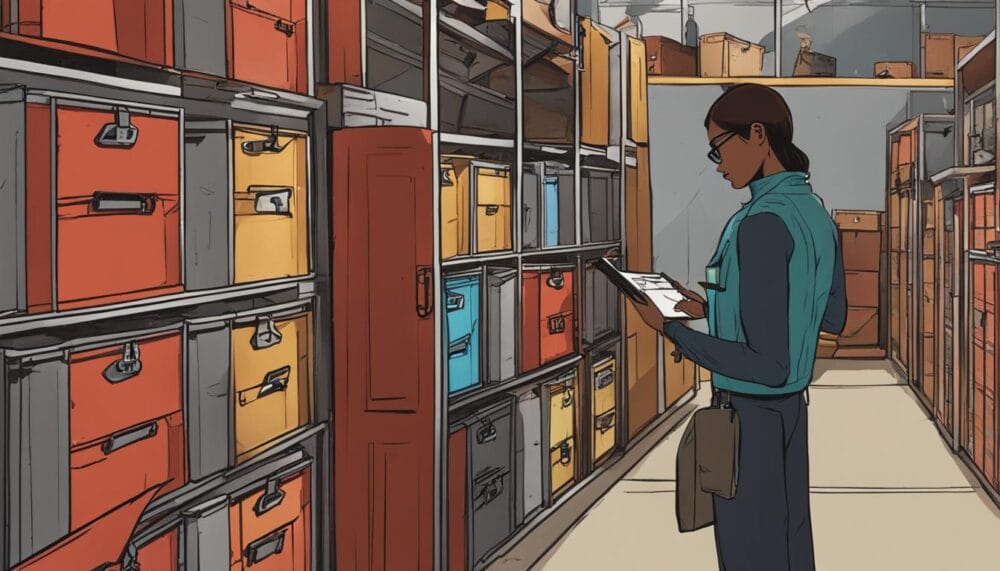When it comes to organizing your life’s accumulations, choosing the right storage unit is an essential step that demands attention and foresight. Your quest for the best storage units should not be a rush to simply stow away belongings; it’s an opportunity to ensure they are kept safe, secure, and accessible. Whether you’re transitioning between homes, craving decluttered living spaces, or just in need of an extra closet, the vast world of self-storage options provides a solution to every spatial challenge.
Imagine stepping into a world of affordable storage rentals tailored to fit your possessions like a glove. The goal is to find local storage facilities that offer not just space, but secure storage solutions that cater to your unique needs. With today’s public storage availability, you can choose from a variety of sizes, from compact temporary storage units to ample spaces that seem like an extension of your home. Renting storage space doesn’t have to feel like navigating a maze. Let’s dive into the essentials of personal storage services and help you streamline your storage unit selection with confidence.
Key Takeaways
- Assess your space requirements and balance them against cost-effective storage unit options.
- Discover secure storage solutions that offer protection and peace of mind for your belongings.
- Explore the convenience of local storage facilities with a range of services and sizes.
- Understand the benefits and flexibility of renting storage space for personal use.
- Navigate the world of affordable storage rentals and find the best deals available.
- Capitalize on public storage availability to match fluctuating space needs effortlessly.
- Embrace a decluttered lifestyle with the help of personal storage services that suit your life transitions.
Understanding Storage Unit Sizes and Capacities
When embarking on the journey of decluttering your space or planning a move, the key to success lies in selecting the right storage solution. Various storage unit sizes and flexible options such as portable containers and rental trucks accommodate different needs. Whether opting for long-term storage or just packing for a short-term transition, understanding how to match storage capacities to your household size ensures a smooth and organized experience.
Identifying Your Storage Needs Based on Home Size
It starts with evaluating the square footage of your living space, carefully considering additional areas like your garage, basement, or attic. Your selection should mirror the quantity and type of belongings you possess. Here’s a snapshot of how home sizes may correlate with different storage unit sizes:
| Home Size | Recommended Storage Size | Ideal for |
|---|---|---|
| Studio/1 Bedroom Apartment | 5’x10′ Unit | Basic furnishings, boxes, small appliances |
| 2-3 Bedroom Home | 10’x15′ Unit | Large appliances, furniture sets, miscellaneous items |
| 4+ Bedroom Home | 10’x20′ Unit or Larger | Entire household, vehicles, extensive equipment |
A Comparison of Storage Options: Containers, Units, and Trucks
If your goal is to maintain a nimble and adaptable storage strategy, weighing options between portable storage containers, traditional storage units, and rental trucks is crucial. For example, a PODS container may be the perfect fit for temporary needs, while a storage unit at a secure facility could satisfy your long-term storage demands.

Maximizing Space: Stacking Strategies and Organization Tips
Efficiency is key when it comes to packing for storage. Utilizing the full height and creating a systematic organization can drastically improve your unit’s usefulness. Sturdy, stackable boxes and vertical shelving are a must, and remember to craft clear paths within the unit for easy access as this can enhance storage unit organization.
- Begin stacking from the back and the bottom, placing heavier items as the base
- Label boxes on all sides for quick identification
- Create an aisle space if frequent access to the unit is necessary
Consider these self-storage tips and design your packing approach not only to maximize space but to ensure that retrieving your items doesn’t become a cumbersome task. Choosing the right storage unit features such as climate control or drive-up access can also elevate your storage game to the next level.
Securing the Best Deals for Storage Unit Selection
When considering affordable storage rentals, the key is to accurately gauge what you need versus spending on unnecessary space. A small storage unit, ideal for those with fewer belongings, can significantly lower your storage unit costs, keeping your budget in check. Conversely, larger units provide ample room but at a higher price point.

Delving into storage unit deals and storage unit discounts can result in considerable savings. Keeping an eye out for special offers or seasonal discounts might reduce expenditures, stretching your dollar further. Before finalizing any storage unit reservations, compare the promotions from various facilities.
Understanding the nuances of storage unit costs is crucial while choosing a storage facility. To assist you in decision-making, consider the following comparative analysis based on sizes:
| Unit Size | Cost Comparison | Best Used For |
|---|---|---|
| Small (up to 50 sq ft) | Cost-efficient for minimal storage needs | Seasonal items, personal documents, small furniture |
| Medium (up to 150 sq ft) | Suits an apartment’s worth of items | Multiple furniture pieces, appliances, boxes |
| Large (up to 300 sq ft) | Accommodates extensive household belongings | Full home’s worth of furniture, vehicles, equipment |
When choosing, remember that easily accessible storage unit access enhances convenience, particularly if you frequently need to retrieve items. It’s not just about finding the lowest price, but also considering how a unit’s location and access hours fit into your lifestyle.
If your possessions are valued less than the yearly expense of a storage unit, it might be time to rethink your strategy—perhaps selling or donating items to avoid steep storage unit costs. Smart choice-making ensures that you select a secure, appropriately-sized unit without breaking the bank.
The Importance of Accessibility in Storage Units
When it comes to selecting a storage unit, prioritizing accessibility will make your experience much smoother. Whether you’re in the middle of a move, or looking to declutter your space, how easily you can get to your possessions is something you’ll want to consider carefully. Let’s explore what you should keep in mind when evaluating the convenience of storage unit locations and access features.
Storage Unit Location Considerations
Finding the ideal storage unit location is more than just picking the nearest facility. It’s about balancing convenience with cost, safety, and access. A close-to-home storage unit location can save you time and travel expenses, especially if you anticipate frequent visits to your stored goods. If your chosen location is a distance away, consider the benefits – such as better rates, enhanced security, or the availability of specialized storage unit leases.

Understanding Storage Unit Access Hours and Restrictions
Your schedule doesn’t always align with business hours, which is why 24-hour storage units are an appealing option. Flexible access means you can retrieve or deposit items on your time, not just during the standard 9-5. When reviewing leases, verify the access hours to ensure they meet your needs. Facilities offering drive-up storage units can further maximize convenience by enabling easy loading and unloading directly from your vehicle.
Unit access is compounded by safety concerns. Facilities equipped with sufficient storage unit lighting increase visibility and reduce the risk of accidents or potential theft. When you’re comparing options, don’t overlook indoor storage units, which often offer controlled environments for temperature-sensitive items and additional security measures that might not be available in outdoor units.
Navigating the world of storage units doesn’t have to be a challenge. By focusing on strategic location choices and flexible access options, you can ensure that your storage solution bolsters, rather than hinders, your dynamic lifestyle.
Investigating Storage Unit Security Measures
When considering a place to store your treasured belongings, the importance of robust storage unit security cannot be overstressed. The right secure storage solutions not only deter potential intruders but also afford you peace of mind when you’re away from your items. High-quality outdoor storage units equipped with cutting-edge security features should be at the top of your checklist as you embark on renting storage space.
Exploring Advanced Security Features
Don’t hesitate to inquire about the presence of surveillance cameras, which provide a watchful eye over your possessions around the clock. Gated access ensures that only authorized individuals can enter the premises, offering an additional layer of protection. Additionally, individual unit alarms alert facility managers and, potentially, law enforcement to any unauthorized access, safeguarding your items even further. These advanced security measures contribute significantly to the integrity and reputation of storage facilities.
Evaluating Local Storage Facilities for Ultimate Peace of Mind
Before you finalize your decision, take the time to assess the cleanliness and ongoing maintenance of the facility, as these factors speak volumes about the management’s dedication to security and care. Clean storage units are less likely to harbor pests that could damage your belongings, and a well-maintained site is indicative of attentive staff and efficient operations. Also, delve into storage unit rules and the availability of storage unit insurance – both can define your rights and the extent of coverage for your items. Remember, beyond the physical security features, understanding the facility’s rules and available insurance options ensures a fully informed choice for safeguarding your possessions.
FAQ
How do I determine the right size storage unit for my needs?
Begin by assessing the total square footage of your home, including spaces like your garage, basement, or attic. Use a size chart to match your home size with the corresponding storage unit size. Consider how efficiently you pack and load your items, and remember to take into account the stacking and organization of your belongings. Online tools and space calculators that offer virtual visualizations can also help you estimate your spatial requirements.
What are the differences between containers, storage units, and rental trucks?
Portable storage containers, such as those offered by PODS, can be conveniently placed in your driveway and are suitable for both short-term and long-term storage with staggered delivery options. Traditional self-storage units are fixed in location and vary in size, offering indoor and drive-up options. Rental trucks are typically used for transporting items from one location to another rather than for storage.
How can I maximize space in my storage unit?
To maximize the space in your storage unit, stack items from the bottom up, utilizing the full height of the unit. Place heavy and bulky items at the bottom and lighter ones on top. Create aisles for easy access to items you may need, and use uniform box sizes when possible for efficient stacking. Disassemble furniture if feasible, and store items inside hollow or large items like appliances and wardrobes to conserve space.
How do I find the best deals on storage units?
Research and compare the costs of various local storage facilities, looking for promotions and discounts. Consider the value of the items you are storing versus the cost of the unit to determine if downsizing could be a more cost-effective option. Additionally, inquire about any special deals for long-term rentals, or check if there are any perks for new customers or seasonal discounts.
What should I consider when choosing the location of a storage unit?
The location of a storage unit should be convenient for you, either close to your home or workplace. Consider how often you’ll need to access your unit and during what hours. Assess the outdoor space required if you’re considering a portable storage container. Ensure that the location is secure, well-lit, and provides the type of unit access you prefer, such as drive-up or indoor.
What are storage unit access hours and restrictions?
Access hours and restrictions vary by facility. Some offer 24-hour access, while others may have set times during which you can enter the property. Restrictions can also include rules regarding the types of items you can store, how you should lock your unit, and whether you’re allowed to work inside your unit. Always check with the facility for specific rules and hours of operation.
What should I look for in terms of security for a storage unit?
When evaluating the security of a storage unit, check for facilities equipped with surveillance cameras, gated access, individual unit alarms, and good lighting. Cleanliness and regular maintenance are also indicators of a secure and well-maintained facility. Additionally, consider purchasing insurance for your stored items for extra peace of mind, and read reviews to learn about the experiences of others with security at the facility.
How do I evaluate a local storage facility?
To evaluate a local storage facility, visit the location to inspect the cleanliness, maintenance, and security features first-hand. Inquire about the facility’s rules and insurance policies. Talk to the staff and ask questions about anything that concerns you. Reading reviews and testimonials from current and previous customers can also provide valuable insight into their experiences and the facility’s reputation.






